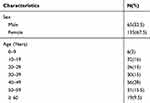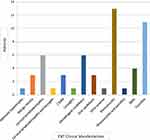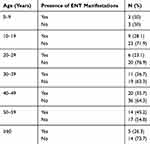Back to Journals » HIV/AIDS - Research and Palliative Care » Volume 12
Prevalence of Ear Nose and Throat (ENT) Manifestations Among HIV Seropositive Patients at a Tertiary Hospital in Northern Tanzania: A Descriptive Cross-Sectional Study
Authors Shija PS, Karaba JA, Philemon RN , Minja BL, Mtenga PP, Katundu DR
Received 11 May 2020
Accepted for publication 9 September 2020
Published 16 September 2020 Volume 2020:12 Pages 425—429
DOI https://doi.org/10.2147/HIV.S260908
Checked for plagiarism Yes
Review by Single anonymous peer review
Peer reviewer comments 3
Editor who approved publication: Professor Bassel Sawaya
Peter Stephen Shija,1,2 Joshua Alexander Karaba,1,2 Rune Nathaniel Philemon,1,3 Bernard Lucas Minja,1 Philbert Patrick Mtenga,1,2 Denis Robert Katundu1,2
1Kilimanjaro Christian Medical Center Moshi (KCMC), Moshi, Tanzania; 2Department of Ear Nose and Throat (ENT) Head and Neck Surgery, Kilimanjaro Christian Medical University College (KCMUCo), Moshi, Tanzania; 3Kilimanjaro Christian Medical University College, Institute of Public Health Moshi, Moshi, Tanzania
Correspondence: Peter Stephen Shija
Department of ENT Head and Neck Surgery, Kilimanjaro Christian Medical University College, P.O Box 2240, Moshi, Tanzania
Tel +255754392916
Email [email protected]
Background: To date, HIV/AIDS remains a threat of the 21st century. The overall rate of new HIV infection continues to decline in several countries, but there is still a remarkable burden of disease seen in sub-Saharan Africa. Several studies observed that 70% to 90% of HIV-infected patients present with ear, nose and throat symptoms. The aim of this study was to identify the magnitude of ENT manifestations among HIV-infected patients attended HIV clinics at KCMC based on age, sex, and CD4 count.
Methods: This was a descriptive cross-sectional study conducted at KCMC hospital involving HIV-infected patients who attended HIV clinics from February to July 2018. Convenient sampling was employed to get study participants, and 200 patients were recruited in the study. Data were collected through a questionnaire from patients, and results were analyzed using SPSS version 20.
Results: Sixty-eight (34%) of 200 HIV-infected patients had ENT manifestations. The most affected age group was 0– 9 years. ENT manifestations were more prevalent in females (23.5%) than in males (10.5%). Those with CD4 count less than 200cells/μL also it was a high prevalence (56.3%).
Conclusion: This study observed that one-third of the studied population had ENT manifestations. All medical practitioners should be aware of ENT manifestations in HIV-infected patients in order to assure early and appropriate intervention.
Keywords: ENT manifestations, HIV, magnitude, seropositive, Tanzania
Background
Human immunodeficiency virus (HIV) is a retrovirus that infects cells of the immune system impairing their function and results in deterioration of the immune system. The virus infects and damages helper T-cells, weakens both cell-mediated and humoral immunity, and increases susceptibility to encapsulated organisms such as Streptococcus pneumoniae and other bacteria. Destruction of both cell-mediated and humoral immunity predisposes an individual to develop acquired immunodeficiency syndrome (AIDS) with ear nose and throat (ENT) manifestation. Commonly reported ENT manifestations in HIV-positive patients include; oral candidiasis, lymph node enlargement, rhinosinusitis, allergic rhinitis, lymph node enlargement in the neck, adenoid enlargement, and chronic suppurative otitis media.1–8
Several studies have observed that 70% to 90% of HIV-infected patients will present with ear, nose and throat symptoms, so our research aimed to identify the prevalence of ENT manifestations among clients attending HIV-clinics at KCMC. Knowing the prevalence will create a high index of suspicion to physicians and health-care providers in encouraging HIV testing to patients presenting to hospital with ENT symptoms. Also, by knowing how commonly used HIV clinical markers associated with ENT manifestations, it will be possible to devise ENT screening schedules for clients of HIV-clinics.
Methods
Study Design and Time
This was a descriptive hospital-based cross-sectional study conducted from February to July 2018.
Study Area
This study was conducted at Kilimanjaro Christian Medical Centre, a consultant hospital in Kilimanjaro, Northern Tanzania, serving a population of approximately 7,503,807 inhabitants. It is the only hospital with an ENT department in the zone. In addition to the ENT clinic, the hospital has three dedicated HIV clinics, namely Care and Treatment Clinic (CTC), Child-Centred Family Care Clinic (CCFCC), Infectious Disease Clinic (IDC) which also served as a setting for this study.
Study Population
All HIV-positive patients both adult and children who attended any of the HIV clinics or the ENT clinic were recruited and invited to participate in the study.
Inclusion Criteria
We included all patients who were HIV test positive attending at any of the clinics and ENT clinic during the study period.
Exclusion Criteria
Patients or care takers who were not willing to participate in the study were excluded.
Variables
The main outcome of interest in this study were adenoids hypertrophy, allergic rhinitis, cervical lymphadenopathy, CSOM, laryngitis, esophageal candidiasis, oral candidiasis, otitis externa, rhinosinusitis, Sensorineural hearing loss (SNHL) and tonsillitis, the independent variables being age, sex and CD4 count.
Data Collection Tools and Methods
Potential study participants in HIV clinics were approached by a researcher and consented to participate in the study. A pretested questionnaire was used to capture the patient’s demographic and illness history. A headlight and otoscope were then employed by the researcher to examine the ears, nose and throat of the patient in an attempt to identify any ENT condition, fiberoptic nasolaryngoscope was used at the ENT clinic to examine patients whom we suspected to have nasopharyngeal tumor or history of nasal bleeding. The findings of the examination were recorded along with the demographic and clinical history.
Ethical Clearance
This study adheres to Declaration of Helsinki, ethical clearance was obtained from KCMUCo Research Ethics Committee with certificate number 2373. For all those who were identified as having an ENT condition were channeled towards the appropriate treatment avenues.
Data Analysis
Data entry, cleaning, and analysis were done using IBM® SPSS® version 24. Descriptive analysis was done for all variables studied; continuous data were summarized into measures of central tendency with their respective measures of dispersion. Categorical data were summarized into frequencies and percentage.
Results
Demographic Characteristics of Study Participants
Two-hundred HIV seropositive patients that attended at KCMC hospital between February and July 2018 were studied to determine the magnitude and distribution of ENT manifestations by age, sex and CD4 count. All patients were already enrolled on highly active antiretroviral therapy (HAART) by the time of this study. Their age ranged from 4 to 78 years (median age of 40 years). Majority of participants were females 135 (67.5%). The demographic characteristics of participants are shown in (Table 1).
 |
Table 1 Demographic Characteristics of Study Participants (N=200) |
Distribution of Clinical ENT Manifestations
Rhinosinusitis was the most common clinical manifestation, present in 13 (24%) out of 68 patients who presented with ENT manifestations. The distribution of other clinical ENT manifestations is summarized in (Figure 1).
 |
Figure 1 Distribution of ENT clinical manifestations. |
Proportion of HIV Seropositive Patients Presenting with ENT Manifestations by Age
During the study period, 68 (34%) patients out of 200 presented with ENT manifestations. Most cases were in the age group of 40–49 but in terms of proportions within the age groups, the highest proportions were in the age groups 0–9 years (50%), and 14 in 50–59 years (45.2%). Table 2 shows the ENT manifestations that we saw in the study participants.
 |
Table 2 ENT Manifestations According to Age Groups (N=200) |
ENT Manifestations Among HIV Seropositive Patients by Sex
The prevalence of ENT manifestations among females was higher (23.5%) compared to males (10.5%). This difference was however not statistically significant (Table 3).
 |
Table 3 ENT Manifestations by Sex (N=200) |
ENT Manifestations Among HIV-Infected Patients by CD4 Count
ENT manifestations among patients with CD4 count less than 200 cells/µL were seen in 56.3% of patients, while amongst those with a CD4 count between 200 and 499 cells/µL, they were in 52.5% of patients, and in those with CD4 count greater or equal to 500 cells/µL, 34% (Table 4).
 |
Table 4 ENT Manifestations by CD4 Count (N=200) |
Discussion
The prevalence of ENT manifestations amongst the 200 HIV-positive participants we recruited in our study was 34%; which is comparable to that in a study done at Muhimbili National Hospital by Swai who reported a prevalence of 34.1%.9 Both of these studies however show a marked contrast to a prevalence of 61.8% reported in Iran by Jafari et al We postulate this difference to be due to the difference in sample size as Jafari study had a sample size of 98.10
A 2006 study in India with a sample size of 968 HIV seropositive patients reported a prevalence of 79% for ENT manifestations.4 At the time of the India study, not all patients were on HAART, making it likely that they had lower CD4 counts compared to our patients, and thus they had a higher prevalence. Our finding of patients with low CD4 having more ENT manifestations supports this hypothesis.
In this study, 3(50%) patients in the age group 0–9 years showed a higher prevalence of ENT manifestations and 6(23.1%) patients of age group 20–29 years were the least prevalent with ENT manifestations. In comparison, a study done at Muhimbili National hospital observed the most prevalent age group was 20–29 years in 12 (50%) patients while the least prevalent group was 50–59 years with 7(24.1%) patients.9 We speculate this difference to be the result of numbers.
Our study did not find any statistical association between sex and the ENT manifestations, despite the proportion of females with ENT complaints being higher. This is contrary to a study done at Muhimbili National Hospital where the prevalence of ENT manifestations was higher among males 35.7% than female 33.3%; this was however not statistically significant.9 In Iran, ENT manifestations have also been found to be higher in men compared to women but this was also not statistically significant.10 Empowerment of women in our study area and the better health seeking behavior of men compared to women might have contributed to the higher proportion of women in our study.
We found that ENT manifestations decreased as CD4 counts increased. Swai in Muhimbili Tanzania found a similar trend. It is plausible that as a person’s CD4 count drops and the person becomes more prone to opportunistic infections, the likely hood of developing ENT manifestations as part of the opportunistic infections increases.9 Some ENT conditions are recognized as opportunistic infections in HIV and have been used in the WHO clinical staging of HIV.11
Although this study succeeded in highlighting some common ENT manifestations, it was limited in the number of patients that were reached due to time limitations. Also, being conducted in a tertiary hospital, it is possible that milder ENT manifestations may exist in lower health facilitates and are not picked up by clinicians.
Conclusion
Of the 200 HIV-positive patients we examined, 34% had ENT manifestations. These were however not their presenting complaints and were uncovered as a result of our screening. We found that as CD4 count drop, there more patients had ENT manifestations. We therefore recommend that all clients seeking care at HIV-clinics, particularly those with CD4 counts below 500 cells/µL be screened for ENT conditions.
What is Known About This Topic?
HIV is the most common cause of AIDS; several studies have documented that 70% to 90% of HIV-infected patients will present with ENT manifestations during the course of the disease. Even asymptomatic HIV patients tend to have ENT conditions when screened.
What This Study Adds
The need to screen HIV patients for ENT conditions particularly those with low CD4 counts.
Acknowledgment
Our sincere thanks go to the staff of IDC, CTC, CCFCC and ENT clinics for their cooperation and support during data collection; we appreciate the contribution from the medical record department to enable us to extract information from patients’ files.
Disclosure
The authors declare that they have no competing interests.
References
1. CDC. Opportunistic infections | living with HIV | HIV basics | HIV/AIDS | CDC [Internet]. Opportunistic infections. 2015. Available from: https://www.cdc.gov/hiv/basics/livingwithhiv/opportunisticinfections.html.
2. National Institute of Allergy and Infectious Diseases. The HIV life cycle | understanding HIV/AIDS | aIDSinfo [Internet]. [
3. Viswanatha B. Otolaryngologic manifestations of HIV infection. J Hematol Malig. 2012;2(2):33–38.
4. Prasad HKC, Bhojwani KM, Shenoy V, Prasad SC. HIV manifestations in otolaryngology. Am J Otolaryngol. 2006;27(3):179–185.
5. Lubbe DE. HIV and ENT. Contin Med Educ. 2004;22(5):2002–2005.
6. Taipale A, Pelkonen T, Taipale M, et al. Otorhinolaryngological findings and hearing in HIV-positive and HIV-negative children in a developing country. Eur Arch Oto-Rhino-Laryngology. 2011;268(10):1527–1532. doi:10.1007/s00405-011-1579-x
7. Sanjar FA, Queiroz BEUP, Miziara ID. Otolaryngologic manifestations in HIV disease: clinical aspects and treatment. Braz J Otorhinolaryngol. 2011;77(3):391–400.
8. Van Der Westhuizen Y, Swanepoel DW, Heinze B, Hofmeyr LM. Auditory and otological manifestations in adults with HIV/AIDS. Int J Audiol. 2013;52(1):37–43. doi:10.3109/14992027.2012.721935
9. Swai H. Otorhinolaryngological manifestations among HIV infected patients attending HIV clinic at Muhimbili. 2011.
10. Jafari S, Razmpa E, Saeedinejad Z, et al. Otolaryngological manifestations in HIV infected patients, Tehran, Iran. J AIDS Clin Res. 2012;3(6):3–6. doi:10.4172/2155-6113.1000160
11. Tanzania Commission for AIDS (TACAIDS) Dar es Salaam T, Zanzibar ZAC (ZAC), National Bureau of Statistics (NBS) Dar es Salaam T, Zanzibar O of CGS (OCGS), ICF International Calverton MU. HIV/AIDS and malaria indicator survey 2011–12. 2011.
 © 2020 The Author(s). This work is published and licensed by Dove Medical Press Limited. The full terms of this license are available at https://www.dovepress.com/terms.php and incorporate the Creative Commons Attribution - Non Commercial (unported, v3.0) License.
By accessing the work you hereby accept the Terms. Non-commercial uses of the work are permitted without any further permission from Dove Medical Press Limited, provided the work is properly attributed. For permission for commercial use of this work, please see paragraphs 4.2 and 5 of our Terms.
© 2020 The Author(s). This work is published and licensed by Dove Medical Press Limited. The full terms of this license are available at https://www.dovepress.com/terms.php and incorporate the Creative Commons Attribution - Non Commercial (unported, v3.0) License.
By accessing the work you hereby accept the Terms. Non-commercial uses of the work are permitted without any further permission from Dove Medical Press Limited, provided the work is properly attributed. For permission for commercial use of this work, please see paragraphs 4.2 and 5 of our Terms.
